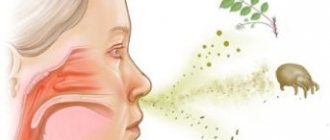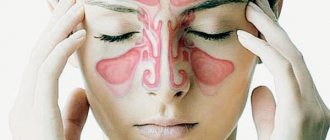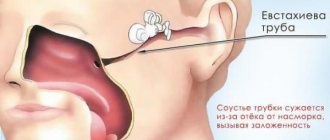Symptoms of an “ear cold”
You can recognize an “ear cold” yourself by the following symptoms:
- sharp pain that can make itself felt both in one ear and in two at the same time;
- swelling and redness around the hearing organs;
- elevated body temperature.
In addition, patients often complain of insomnia, because sharp pain simply does not allow them to rest properly. If you have the above symptoms, you should never postpone a visit to the doctor, since otitis media can even cause complete or partial hearing loss.
At the initial stage of the disease, only pain inside the ear may bother you.
Initially, the unpleasant sensations may not even cause discomfort, but after a while the pain will intensify, and the person will not be able to even swallow food painlessly. As the pathology develops, the general condition will deteriorate, headaches will begin to constantly bother you, and your performance will decrease significantly. If a small child starts to have ear pain, he will become moody and irritable.
Of course, young children are not able to tell what exactly is bothering them, so parents should very carefully monitor the health of their children and prevent the development of complications. If, when lightly pressing on the earlobe, the child screams in pain, upon examination you notice that the eardrum is swollen and red, you should contact an ENT doctor.
Treatment of pathology
Doctors strongly recommend not to treat any ear disease yourself. It is important to understand that the hearing organs should be considered as a very complex and at the same time fragile system. If, in the patient’s opinion, even an uncomplicated otitis media is not fully treated, such a complication can lead to complete hearing loss, both in children and adults. Only a timely visit to an experienced doctor and an effective treatment method will help get rid of otitis media and prevent the development of further complications. Quite often, childhood acute otitis media takes on a more serious – chronic form, so don’t hesitate to visit the clinic.
There are several ways to relieve acute pain before visiting a doctor:
- put vasodilator drops into the nose;
- soak cotton wool with camphor alcohol and place lotions in the ear canal;
- Apply a warm compress overnight.
But such actions can only be done to relieve pain, and the next day a visit to an ENT doctor must be carried out. Before visiting a doctor directly, it is not recommended to instill pain-relieving drops into the ear, since the effect of such drugs will not allow the specialist to fully see the picture of the disease and prescribe an effective technique.
After examining the patient, the doctor most often prescribes a comprehensive treatment method. To prevent an abscess, which often develops in the temporal lobe due to otitis media, antibiotics are prescribed. Such drugs in the treatment of “ear colds” will not allow the development of severe intracranial complications. Only the doctor decides which antibiotic will help cure otitis media, taking into account the stage of development of the disease and the age of the patient. The most gentle drug is selected for the child, and during pregnancy, antibiotics are prescribed only in emergency cases.
Therapeutic ear drops are necessarily included in the complex treatment; the name of the medication is indicated by the ENT doctor after examining the patient. Nasal vasodilator drops are the third medication that should be used in the treatment of otitis media. They help relieve swelling from the mouth of the auditory tube and significantly improve the so-called drainage of the mucous surface.
Quite often, at the slightest pain in a child’s ear, caring parents first apply a warm compress. This action, as previously said, is really worth using, but only at the first stage of the development of the disease. If you continue to warm up the hearing organs in case of purulent pathology, then self-treatment sometimes provokes the development of serious intracranial complications, and with external otitis, heating can cause inflammation of the cartilage tissue. If the patient really needs warming, the doctor will prescribe it individually. Most often, a Minin lamp is prescribed for warming up, but only if the patient does not have an elevated temperature.
If a small child complains of pain in the ear, he should be shown to an ENT doctor as soon as possible, and before visiting the hospital, under no circumstances should he warm up or instill any drops in the child’s ear. The fact is that quite often children’s ears begin to hurt not only because of a cold, but also because of the presence of a foreign object in the ear canal, which only a doctor can remove with a special instrument.
Doctors strongly recommend, regardless of the patient’s age, to carry out regular preventive measures that will prevent the development of otitis media. To do this, it is enough to visit the ENT doctor’s office at least once a year. Using an otoscope, a specialist will examine the hearing organs in a couple of minutes and immediately find out whether the patient is developing a pathology. It is important not to forget the following: it is much easier to cure any disease at the initial stage of development and thereby prevent the development of serious complications.
Source: prostudnet.ru
Treatment
What to do if there is congestion in the ears? The doctor selects a course of therapy individually for the patient, taking into account his age, stage and form of the disease. Also, a qualified doctor must take into account the presence of concomitant diseases in the patient.
Traditional drug therapy involves prescribing the following medications:
- Antibiotics. They must be used in the fight against pathogenic bacteria. One of the most effective drugs for ear problems is Amoxiclav. Treatment should be at least a week. But it is very important to remember that you cannot use antibiotics yourself without a doctor’s prescription!
- Vitamins are prescribed to support a weakened body and fill it with useful elements.
- Vasoconstrictor nasal drops are necessary to expand the auditory tube. They will help the process of drainage of pus.
- Antipyretic medications for high fever caused by otitis media.
- Prescribing painkillers for severe ear pain that cannot be tolerated.
- Ear drops. It is important that they are alcohol based. You need to drip this product at least twice a day.
What is flu and sore throat
Influenza is an acute infectious process in the body that is transmitted by airborne droplets.
As it develops, the following symptoms appear:
- temperature increase;
- sore throat;
- chills;
- nasal congestion;
- cough;
- nausea;
- pain in the joints.
Sore throat is characterized by a rather acute onset. Against the background of a normal state of health, a person’s health quickly deteriorates. In this case, the following manifestations occur:
- fever, chills;
- symptoms of intoxication;
- severe sore throat;
- insomnia;
- loss of appetite
- enlarged lymph nodes;
- swelling of the tonsils.
Causes of ear complications
Complications may result from the effects of viruses or bacteria on certain organs. There are factors that increase the risk of complications after flu or sore throat:
- childhood;
- elderly age;
- pregnancy;
- state of immunodeficiency - congenital, HIV infection, use of medications;
- the presence of additional pathologies - diabetes, asthma, obesity.
Otitis media is one of the most common ear complications after a cold. Read more about this in our video:
Ear complications after a cold
Complications in the ear after a cold are a fairly common phenomenon that occurs, most often, as a result of untimely or improper treatment of a cold. Pain, noise, ringing in the ears, hearing loss - all these symptoms indicate that the inflammatory process has spread to the ear area. An extremely dangerous condition is purulent otitis media - such a disorder can lead to complete deafness. In this situation, you cannot hesitate and it is necessary to begin treatment measures as soon as possible. What to do if your ear can’t hear after a cold? We'll talk about the most effective treatment methods below.
How to treat
To cope with complications of flu or sore throat, you need to consult a doctor in a timely manner. After a thorough diagnosis, the specialist will select therapy.
Medication
Typically, when otitis develops, the following types of treatment are required:
- The use of antibacterial drugs is indicated in the presence of a bacterial infection in the body.
- The use of antiviral agents is required when the disease is of viral origin.
- The use of vasoconstrictor drops - such drugs help eliminate swelling, which is often the cause of pain. The most effective remedies include tizin and Nazivin.
- The use of antipyretics is indicated when the temperature increases. The safest drugs include paracetamol and Nurofen.
- The use of anti-inflammatory drops helps to stop inflammation. They should be prescribed by a doctor, since such drugs have many side effects. The most effective substances include otipax and sofradex.
- The use of compresses is indicated only in the absence of purulent discharge. Otherwise, there is a risk of worsening the pathological process.
Popular remedies for treating ear inflammation after the flu
Folk remedies
As a complement to traditional remedies, you can use effective folk recipes:
- Vegetable oils help eliminate aching or shooting pain. You can use almond or nut butter for this. This product can be simply administered into the ears, 2-3 drops at a time.
- Beet. You need to take 1 small vegetable, peel, chop and boil with the addition of honey. Use for insertion into the ear canal.
- Onion. Several pieces of this vegetable are wrapped in gauze and placed in the ear. Thanks to this, you can cope not only with pain, but also eliminate nasal congestion.
- Walnut leaves. You need to take a few fresh walnut leaves and squeeze the juice out of them. Inject 4 drops into each ear.
- Beet juice. Boil the vegetable and then squeeze the juice out of it. Place a few drops in each ear.
- Camomile tea. Take a tablespoon of flowers and add a glass of boiling water. Leave to infuse for half an hour and strain thoroughly. When the broth has cooled, it can be used to rinse the ears.
Folk remedies for the treatment of otitis and other ear infections
Physiotherapy
An important component of otitis treatment is physical therapy. These procedures can be used only after the acute process has been eliminated. Most often, doctors prescribe phototherapy. This is an effective method that allows you to cope with inflammation.
Ultraviolet radiation is also often used. Thanks to this procedure, it is possible to cope with bacterial microorganisms and even strengthen the immune system. Sometimes, to fight viruses and bacteria, you need to use a “quartz tube” for the nose and ultraviolet radiation for the throat.
How to prevent complications
To prevent the occurrence of dangerous complications, you need to be very careful about the treatment of the underlying pathology. To do this, you must strictly follow all doctor’s prescriptions for flu and sore throat:
- The patient must remain in bed. If this is not done, the risk of complications increases significantly.
- Be sure to drink enough liquid. Thanks to this, it will be possible to speed up the removal of toxins from the body.
- Take medications prescribed by your doctor.
- After recovery, you need to limit physical activity for 2 weeks and avoid crowded places. This will restore immunity.
How to be treated without complications in our video:
Possible complications
If your ear hurts after the flu, you need to start treatment without delay. Otherwise, otitis media will turn into a purulent form, which can lead to severe intoxication of the body, pain and copious outflow of pus from the ears.
If the patient has lost hearing due to progressive purulent otitis, the patient will need to pierce the eardrum to prevent pus from penetrating into the intracranial membranes.
Another serious consequence of otitis media that develops against the background of influenza is the transition of the disease to a chronic form. This can cause permanent ear inflammation and even lead to loss of hearing.
Even more serious complications after otitis media are associated with the development of intratemporal and intracranial diseases:
- facial paralysis;
- meningitis;
- intracranial abscess;
- mastoiditis;
- encephalitis;
- hydrocephalus.
Thus, ear complications after suffering from the flu can be very serious. They need to be treated immediately and only according to a protocol drawn up by a specialist.
Prevention
Currently, there are simple rules that will help prevent the occurrence of ear diseases:
- If nasal discharge occurs, it is necessary to carry out the cleansing procedure in a timely manner.
- When blowing your nose, you should avoid straining, as there is a risk of mucus particles getting into the hearing organ. This often causes inflammation.
- Don't let the flu or sore throat take its course.
- It is important to avoid hypothermia and drafts.
Flu and sore throat are considered quite serious pathologies that can lead to undesirable consequences. To prevent the development of otitis media, you must strictly follow all medical prescriptions. If you experience ear pain, you should definitely contact an otolaryngologist.
Source: gidmed.com
Causes and symptoms of ear disease
The main causes of ear disease as complications during and after a cold:
- The increase in lymphoid tissue leads to the closure of the eustachian tube leading to the inner ear. This leads to a feeling of stuffiness in the ears;
- The inflammatory process may be associated with the accumulation of mucus containing pathogenic bacteria;
- Sometimes exudate (fluid) accumulates in the middle ear, which leads to dizziness and nausea.
Catarrhal and purulent otitis media are the most common complications after a cold. The disease is especially common in children. The disease may be accompanied by fever and sleep disturbances. Timely treatment will help prevent the disease from becoming chronic. The presence of the following symptoms indicates the development of an inflammatory process and the need for treatment:
- The most common feeling is a feeling of fullness in the ear;
- Noise and pain in the ears;
- The ear itches and itches;
- The patient does not hear sounds from the inflamed ear.
Principle of development of otitis media
Otitis can develop against the background of many respiratory diseases, but influenza takes a leading place. In this state, an acute viral infection in every possible way reduces the body’s defenses, so the immune system cannot suppress the pathogenic cells that are constantly secreted in the ears.
This leads to the development of bacteria and blocking the outflow of fluid in the ears, as a result of which this mass accumulates and becomes an excellent environment for the development of pathogenic infections (the inside of the ears is dirty, warm and humid, so these conditions are perfect for the proliferation of dangerous microorganisms). This is the principle of the occurrence of otitis media, which is the same in both adults and children.
In the absence of timely treatment, purulent contents begin to be released from the ears. In fact, when pus appears, doctors regard it as a good sign, because then it will not accumulate inside the ear and intracranial cavity. Otherwise, the accumulation of pus inside the ear can lead to much more dangerous consequences.
Ears begin to clog in people with weak immune systems
Doctors identify the following groups of people who are most susceptible to this complication after a viral cold:
- People with weakened immune systems.
- Patients who additionally suffer from severe chronic diseases (heart disease, diabetes, hepatitis, etc.).
- Patients who have bad habits (smoking, drinking alcohol).
- Children under three years of age.
- Patients with asthma.
- Pregnant women.
- Aged people.
We also recommend: Legs hurt after the flu
How to treat ear congestion
Ear congestion usually goes away on its own after a cold, but sometimes special treatment is required.
If you suspect otitis in a child, you should not apply warm compresses, use drops or other medications until a doctor arrives.
Treatment must be prescribed by a doctor during examination and diagnosis. You can normalize the pressure in the Eustachian tube to relieve ear congestion by doing the following exercise: cover your nose and mouth with your hand and exhale deeply. Simply inflating balloons often helps with congestion. Ear congestion can be relieved with a warm alcohol compress used at night.
What is otitis media?
Otitis media is a common middle ear infection. Most often it is diagnosed in young children, but adults also suffer from it.
Symptoms of otitis media:
- a feeling of pressure or fullness in the ear;
- ear pain (sharp, aching or throbbing);
- hearing impairment;
- discharge from the ear;
- tinnitus;
- fever;
- headache;
- irritability;
- dizziness, imbalance;
- vomiting and diarrhea.
Ear infections threaten deterioration and loss of hearing, as well as inflammation of nearby organs - the skull bones (including the auditory ones), the membrane of the brain, facial nerves, etc.
Complications develop only with improper treatment or its absence.
Medicines that relieve ear pain
Otipax copes well with the inflammatory process inside the ear, destroying pathogens in the area of the eardrum. It also relieves pain from ear infections caused by colds. Instill 5 drops twice a day. Has no contraindications. Otinum is a medicine used for acute otitis media, as well as for complications during a cold. It relieves inflammation and pain well. Place 3 drops in the ear at intervals of six hours. The medicine should not be taken without consulting a doctor. If the pain does not go away within a week, the drug needs to be changed. Sofradex is a drug containing antibiotics. It has a wide spectrum of action and is used to relieve pain and relieve inflammation. Available both in the form of drops in the ear and in the form of an ointment. It has a number of contraindications, including a ban on treatment for a perforated eardrum.
The drug is used only on the recommendation of an otolaryngologist.
If pus appears from the ear, you must immediately stop warming and instilling. Usually at this stage the pain subsides and purulent discharge from the ear appears. The doctor prescribes antibiotics for purulent otitis media.
Folk remedies
Ear pain can be treated at home using traditional medicine.
The most effective folk recipes for the treatment of otitis media are:
- A remedy made from a solution of Dimexide and boric alcohol is a proven “grandmother’s” method that can relieve the inflammatory process in the shortest possible time. To do this, you need to mix these 2 ingredients in equal parts, moisten the cotton wool, squeeze it a little and place it in the ear for an hour. The solution should be at comfortable room temperature. You need to repeat it twice a day.
- Hydrogen peroxide product. It has disinfectant properties, and thus will rid the ear of pathogens. You need to dilute peroxide in water and instill 5 drops into the inflamed ear twice a day.
- Chamomile infusion is great for severe ear pain. It is necessary to brew 1 tablespoon of chamomile with half a glass of boiling water and leave for 45-60 minutes. After this, strain the infusion. Next, you need to take 1 tablespoon of hydrogen peroxide and dilute with 1 teaspoon of chamomile infusion. The resulting product should be used to rinse the sore ear. To do this, draw the solution into a syringe and slowly inject it into the ear.
- To eliminate pain, you need to heat camphor oil and drop 2 drops into the ear. In case of severe pain, you can make cotton pads and soak them in oil.
In case of otitis, it is forbidden to instill pure alcohol into the auricle, since the pain can only cause a burn in the ear cavity and make warm compresses for an abscess with pus.
Prevention of complications due to a runny nose
When you have a runny nose, you must follow these rules:
- Regularly clear your nose of accumulated mucus. Before using vasoconstrictors, it is necessary to rinse your sinuses. This can be done using a saline solution (1 teaspoon of salt per glass of warm boiled water). After the procedure of cleansing the nasal cavity, a runny nose is treated with drops: Glazolin, Nazol and others;
- There is no need to blow your nose too much, as bacteria can enter the middle ear cavity and cause inflammation;
- Use medications to block the spread of infection;
- Treatment of purulent otitis does not allow cleaning the ear with cotton swabs. Pus is removed using cotton swabs soaked in hydrogen peroxide;
- After curing a cold, it is necessary to undergo a preventive examination by an otolaryngologist to prevent complications from becoming chronic.
Thus, you must always remember that even a common cold in the form of a runny nose and cough can cause a complication such as otitis media, in which the ear becomes inflamed and hurts. The first thing to do if you suspect otitis media is to consult a doctor. There is no need to self-medicate, as this can lead to chronic complications or even hearing loss. Treatment with folk remedies after the occurrence of a complication (warming compresses or tinctures of medicinal herbs) is also recommended to be agreed with the attending physician.
Source: gorlouhonos.ru
Main types of complications
Each person has organs and systems that are most susceptible to hypothermia and the penetration of the virus into the body. Complications most often occur precisely where there are chronic illnesses or local immunity is weakened for some reason. Below are all the possible options.
Nose
The most common complication of the sinuses is sinusitis - sinusitis and sinusitis. They are manifested by severe headaches localized in the forehead and bridge of the nose, nasal congestion, general malaise, fever, swelling and sensitivity of the face. If you suspect sinusitis, you should visit a doctor as soon as possible, since the patient may be prescribed antibacterial therapy or even surgery.
Throat
Often the consequence of an untreated cold is tonsillitis (acute tonsillitis). It is difficult not to notice a sore throat - acute pain when swallowing, enlarged lymph nodes, high fever. Most likely, in this case, the doctor will prescribe the patient a course of antibiotics to treat this unpleasant disease.
Ears
If, against the background of a cold, a person develops ear pain and hearing loss along with a high temperature, then he has probably developed otitis media. With this diagnosis, the pain often radiates to the head. You shouldn't joke with otitis media, because untimely treatment can even lead to partial or complete hearing loss.
Respiratory system
The respiratory organs are also very often affected by untreated colds. Depending on where the inflammation develops, the patient is diagnosed with acute tracheitis, bronchitis or pneumonia. With these complications, a severe cough, general weakness, fever, and pain are observed. The nature of the cough and the location of the pain are different.
With tracheitis, cough occurs most often at night and in the morning, as well as as a result of physical impact on the trachea - screaming or laughing. It is dry, hysterical, paroxysmal. The mucus does not come out, so the cough does not bring relief. In this case, after an attack, pain occurs in the chest area.
Tracheitis and bronchitis are similar in their symptoms, but in the second case, in addition to a dry cough, shortness of breath and increasing weakness are observed. Often, when in doubt, therapists make a general diagnosis of tracheobronchitis, since the treatment is similar and is aimed primarily at liquefying mucus and removing it from the body.
Pneumonia (pneumonia) is a more serious disease. Characteristic symptoms: high fever, severe cough with copious sputum, difficulty breathing, possible hemoptysis. Since pneumonia is caused by bacteria, it requires antibacterial therapy - antibiotics, which will be prescribed by a doctor after diagnosis.
Teeth
Sometimes colds provoke toothache. Pain from the nasal sinuses can radiate to the teeth during sinusitis, and inflammation of the trigeminal nerve can also cause it. In the second case, a consultation with a neurologist is required.
Kidneys and urinary system
Complications to the kidneys make themselves felt by lower back pain and fever. If kidney inflammation or pyelonephritis is suspected, the doctor will first order a urine test.
In addition, the urinary system may be affected, leading to cystitis. This is especially true for women, since due to the physiological structure of the body, the likelihood of cystitis in them is much greater than in men.
Joints
The infection can affect the joints, which is especially important for older people. If, 7–10 days after the onset of a cold, the patient notices numbness in the fingers and toes, aching joints, problems bending the limbs, swelling in the joints, then it is necessary to immediately consult a doctor, because untreated or delayed treatment can even lead to disability .
The cardiovascular system
At high temperatures, the load on the heart and blood vessels increases, which can lead to serious complications. The risk group is headed by patients with chronic diseases of the cardiovascular system.
In addition, the infection can directly affect the heart muscle, which will lead to its inflammation - myocarditis. Therefore, if you feel pain or discomfort in the heart area, do not close your eyes to it in the hope that it will go away on its own, but visit your doctor and get an ECG.
Nervous system
The most common complication on the nervous system is facial neuritis. It is manifested by acute pain or slight tingling in one half of the face, as well as a violation of its symmetry. If you notice such symptoms, do not hesitate to make an appointment with a neurologist.
Eyes
If, as a result of a cold, your child’s eyes are swollen, red, watery and purulent, then most likely there is a complication such as conjunctivitis. You need to urgently contact an ophthalmologist to prescribe competent treatment. In adults, conjunctivitis associated with a cold is extremely rare.
How to treat a complication that occurs in the ears after a cold
Symptoms of an “ear cold”
You can recognize an “ear cold” yourself by the following symptoms:
- sharp pain that can make itself felt both in one ear and in two at the same time;
- swelling and redness around the hearing organs;
- elevated body temperature.
At the initial stage of the disease, only pain inside the ear may bother you.
Of course, young children are not able to tell what exactly is bothering them, so parents should very carefully monitor the health of their children and prevent the development of complications. If, when lightly pressing on the earlobe, the child screams in pain, upon examination you notice that the eardrum is swollen and red, you should contact an ENT doctor.
Treatment of pathology
There are several ways to relieve acute pain before visiting a doctor:
- put vasodilator drops into the nose;
- soak cotton wool with camphor alcohol and place lotions in the ear canal;
- Apply a warm compress overnight.
After examining the patient, the doctor most often prescribes a comprehensive treatment method. To prevent an abscess, which often develops in the temporal lobe due to otitis media, antibiotics are prescribed. Such drugs in the treatment of “ear colds” will not allow the development of severe intracranial complications. Only the doctor decides which antibiotic will help cure otitis media, taking into account the stage of development of the disease and the age of the patient. The most gentle drug is selected for the child, and during pregnancy, antibiotics are prescribed only in emergency cases.
Quite often, at the slightest pain in a child’s ear, caring parents first apply a warm compress. This action, as previously said, is really worth using, but only at the first stage of the development of the disease. If you continue to warm up the hearing organs in case of purulent pathology, then self-treatment sometimes provokes the development of serious intracranial complications, and with external otitis, heating can cause inflammation of the cartilage tissue. If the patient really needs warming, the doctor will prescribe it individually. Most often, a Minin lamp is prescribed for warming up, but only if the patient does not have an elevated temperature.
Symptoms of otitis media
How to recognize middle ear inflammation at an early stage? It's quite simple, just notice some of these symptoms:
- small lumbago in the auricle and pulling sensations from the tonsillar to preauricular (parotid) lymph nodes;
- hearing loss. Usually one ear has worse hearing and pain - this is due to slight asymmetry of the face. Afterwards, the inflammatory process spreads to the second ear canal;
- congestion, ringing and noise in the ears. This sensation occurs when the lumen of the Eustachian tube narrows due to swelling;
- feeling of pressure in the ear canal. This is due to the fact that the mucous secretion puts pressure on the eardrum;
- pain in the ear - this symptom indicates the transition of secretory otitis to the acute stage;
- increase in body temperature. With purulent otitis, the readings can be high - up to 39.5 C. With secretory sluggish otitis, no increase in temperature is observed, and in the initial stage of exacerbation the thermometer shows from 37 to 38 C.
Thus, recognizing and treating otitis in the initial stage is quite simple, since the first signs immediately make themselves felt. The complication must be treated without delay, otherwise it can lead to suppuration and perforation of the eardrum, and this often leads to deafness.
If you ignore the inflammatory process in the ear area and do not take any action or self-medicate, the purulent contents can enter the brain. Possible consequences include death!
How to treat a complication that occurs in the ears after a cold
Symptoms of an “ear cold”
You can recognize an “ear cold” yourself by the following symptoms:
- sharp pain that can make itself felt both in one ear and in two at the same time;
- swelling and redness around the hearing organs;
- elevated body temperature.
At the initial stage of the disease, only pain inside the ear may bother you.
Of course, young children are not able to tell what exactly is bothering them, so parents should very carefully monitor the health of their children and prevent the development of complications. If, when lightly pressing on the earlobe, the child screams in pain, upon examination you notice that the eardrum is swollen and red, you should contact an ENT doctor.











